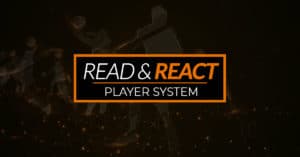As usual, Rick Torbett has shared another great article concerning The Read & React. The Read & React Offense is not engaged (start) until the ball has entered the half-court and has been:
- Passed to a perimeter teammate
- Passed to a posting teammate
- Dribbled At a teammate,
- Driven North-South,
- Power Dribbled, or
- Reverse Dribbled.
Until then, the players without the ball (regardless of how many are in the half-court), can do anything they want to in terms of getting open or getting each other open. This is one of the areas that I left open for coaches to be as creative as they want to be. Coaches could simply give the players a few principles to use during transition. Or, on the other end of the scale, they could create “sets” that direct a player to set a screen for another player at a particular place at a particular time, the options are endless!
Triggers for these different “sets” can by tied into the game very easily at identified times during a game. Here are some examples:
- After made FT by your opponent
- After a missed FT by your opponent
- After a made 2 pt fg by your opponent
- After a made 3 pt fg by your opponent
- When your team inbounds the ball on the side in the backcourt
- When your team inbounds the ball on the side in the frontcourt
- When your team inbounds the ball after a time out
The variables are up to you as the coach, don’t be afraid to change it from quarter to quarter, half to half, or even game to game.
This is especially useful when implementing the Read & React for the first time with almost any team. Most players do not know how to get open on their own because they have learned basketball in the traditional system of Set Plays. This method starts your offense (gets players open) with something they are familiar with (a set play that tells them what to do) while you move them into the new and exciting world of the Read & React.
Interested in learning more about The Read and React Offense? Check out our full line of videos to take your team to the next level.








